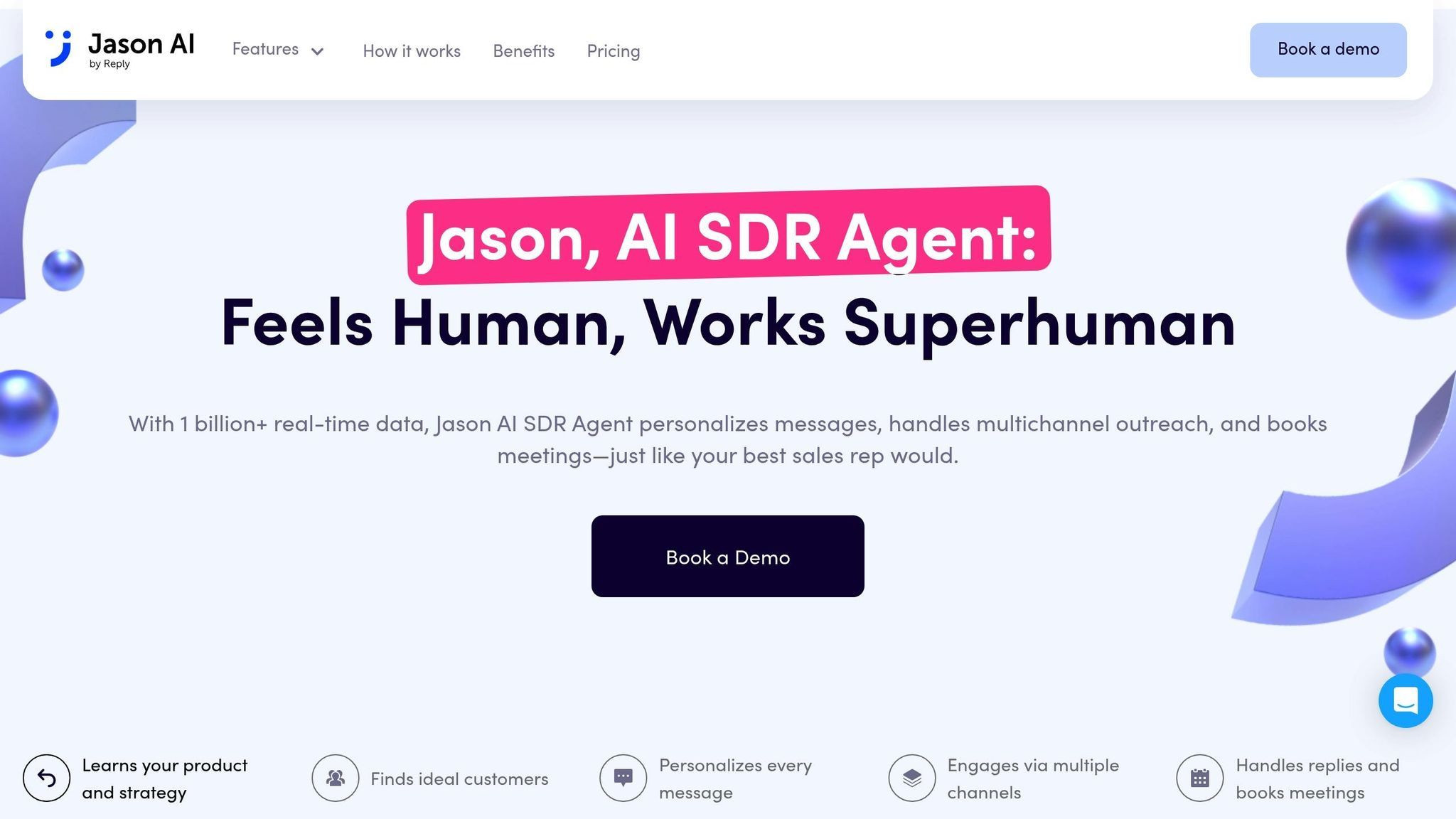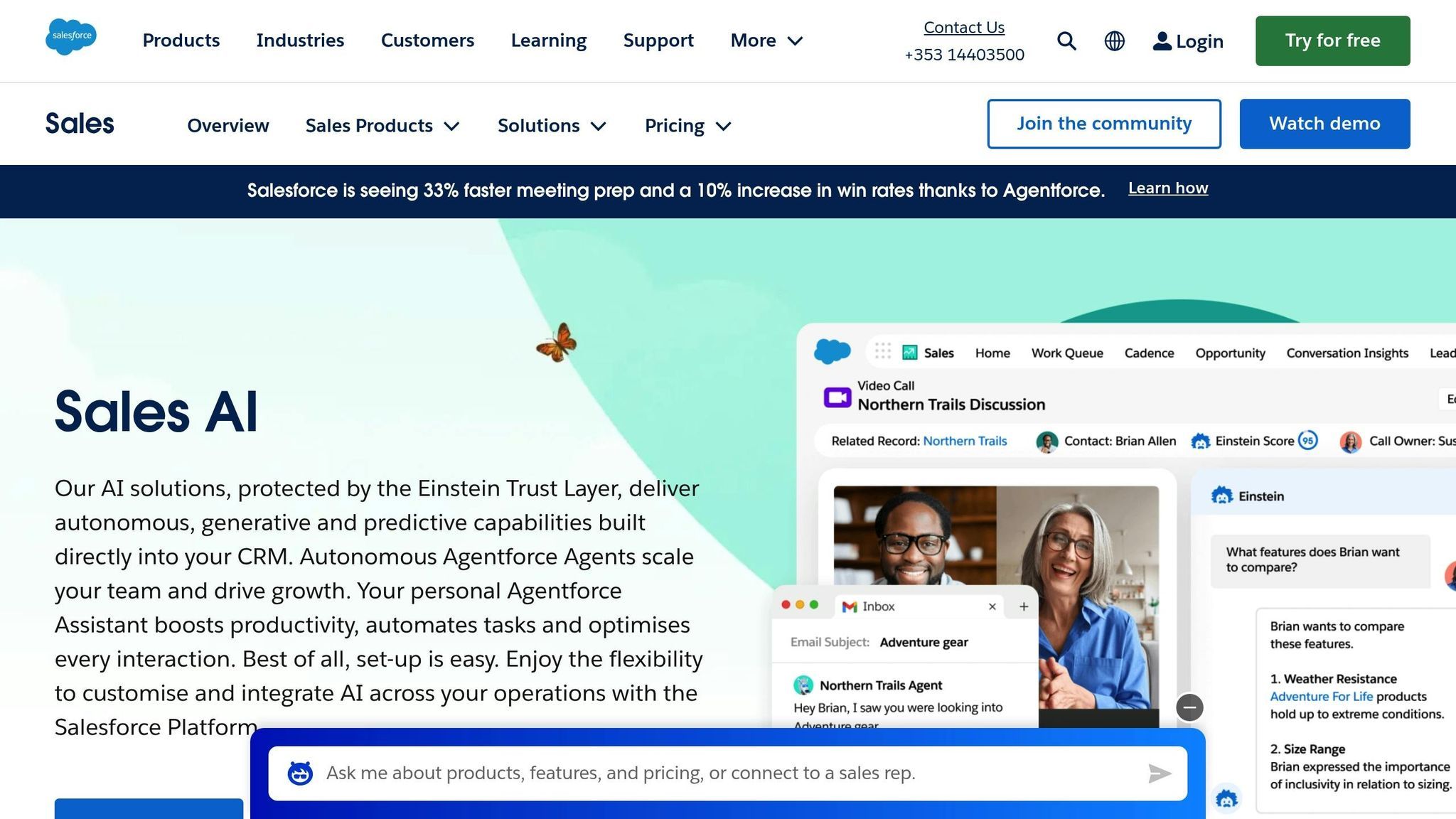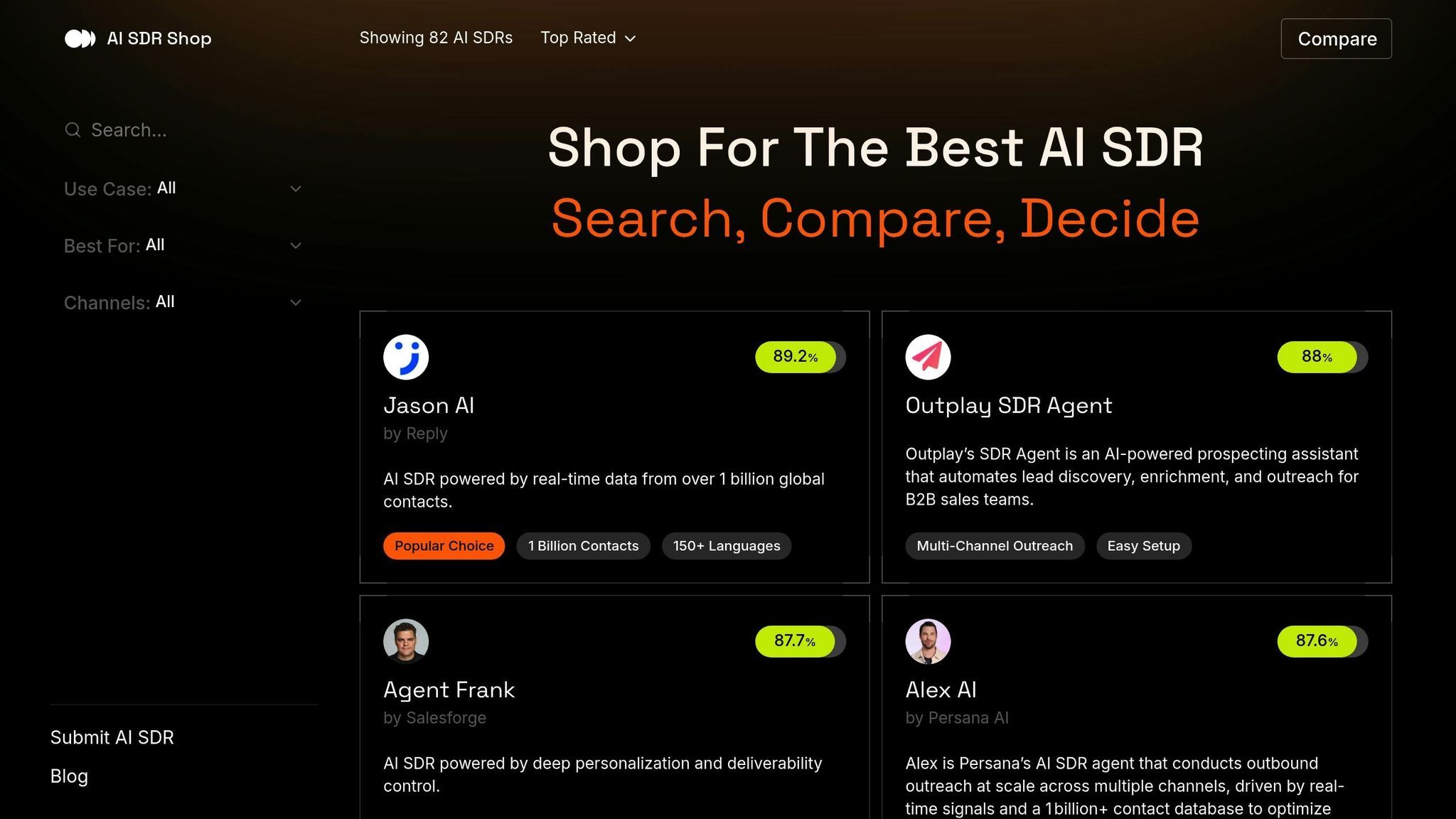How AI SDRs Enable Real-Time Data Sync

How AI SDRs Enable Real-Time Data Sync
AI-powered Sales Development Representatives (SDRs) simplify and speed up sales processes by automating data updates and syncing them across tools like CRMs and email platforms in real time. This eliminates manual errors, ensures accurate data, and allows sales teams to focus on engaging prospects and closing deals. Here's what you need to know:
What They Do: AI SDRs manage lead research, outreach, follow-ups, and CRM updates automatically.
Real-Time Sync: Updates, like email responses or lead interactions, are instantly reflected across all connected systems.
Why It Matters: Faster, error-free data sync improves team efficiency, reduces duplicate efforts, and enhances decision-making.
How They Work: Using APIs and machine learning, AI SDRs integrate seamlessly with tools like Salesforce and HubSpot, ensuring consistent and immediate data flow.
Key Benefits: Less manual work, better data accuracy, quicker lead responses, and smarter follow-ups.
AI SDRs are reshaping sales by automating repetitive tasks and providing instant insights. If you're looking to streamline your sales process, integrating AI SDRs with your tools is a game-changer.
The AI Sales Pipeline Agent (SDR Automation)
::: @iframe https://www.youtube.com/embed/yaMUJFjr6yM :::
How AI SDRs Enable Real-Time Data Sync
AI SDRs are reshaping how sales teams manage data by automating processes and seamlessly connecting systems across your sales ecosystem - no manual effort required.
Automated Data Collection and Syncing
AI SDRs work tirelessly to monitor key touchpoints, capturing every interaction prospects have with your business. Whether it's a website visit, an email open, or a response to outreach, these actions are logged instantly and synced with your CRM, marketing automation tools, and other connected platforms.
But this isn’t just about basic data entry. AI SDRs interpret email responses, gauging sentiment and buying intent to classify leads. They track outcomes from phone calls, schedule meetings, and manage follow-ups, ensuring every detail gets recorded in the right place at the right time. Lead scores and pipeline updates happen automatically, giving your team immediate visibility into the sales process.
When records are incomplete, AI SDRs step in to enrich profiles by pulling additional information from reliable sources. This streamlined data collection builds a solid foundation for smooth integration across your systems.
Connecting AI SDRs With Your Sales Tech Stack
Unlike manual setups, AI SDRs simplify the process of linking your sales tools. Through API and webhook configurations, they integrate effortlessly with leading CRM and email platforms, enabling real-time communication across your tech stack.
The setup process is straightforward: grant system permissions and configure data mapping rules to define how information flows between systems. For instance, you might map lead sources from your AI SDR to specific campaign fields in your CRM or create rules to translate engagement scores into lead quality ratings.
As new data comes in, the AI SDR triggers updates across all connected systems. This two-way sync ensures changes made in your CRM are reflected back in the AI SDR, maintaining consistency throughout your tools.
Security is a top priority. AI SDRs use encrypted connections and follow strict authentication standards to safeguard sensitive prospect data. They also maintain detailed audit trails, ensuring compliance with privacy regulations and internal security policies.
AI Features That Support Real-Time Sync
Advanced AI capabilities take data syncing to the next level, ensuring updates across your tools are accurate and continuous.
Natural language processing and voice-to-text technology allow AI SDRs to analyze conversations, extract key details like budget ranges or decision-maker roles, and instantly create call summaries with actionable insights for your CRM.
Predictive analytics help AI SDRs identify high-converting prospects based on behavior patterns. These insights are updated in real time, enabling your team to prioritize leads dynamically as engagement levels shift.
Smart scheduling tools streamline meeting coordination by syncing calendars, aligning with prospect preferences, and booking appointments automatically. Confirmed details are then updated across all relevant systems.
Machine learning ensures the system gets smarter over time. When sales reps adjust AI-generated entries, the AI learns from these corrections, applying similar logic to future data processing. This ongoing refinement enhances sync accuracy, helping your team work more efficiently and stay focused on closing deals.
Benefits of Real-Time Data Sync for Sales Teams
Real-time data synchronization does more than just streamline your processes - it directly impacts the performance of your sales team. By leveraging the capabilities of AI SDRs, teams can see tangible improvements in productivity, efficiency, and even revenue growth.
Less Manual Work and Higher Efficiency
AI SDRs take over the repetitive, time-consuming tasks that often bog down sales teams. Instead of spending hours on manual data entry, updating CRM records, or transferring information between platforms, your team can focus on activities that actually generate revenue - like building relationships and closing deals.
This automation translates into significant time savings. Tasks that once required constant attention, such as keeping prospect information up to date or tracking engagement across platforms, are handled seamlessly. This gives sales reps more time for high-value activities like prospect calls, negotiations, and strategic planning.
Another key advantage? Instant access to detailed prospect profiles. When a lead interacts with your content - whether by responding to an email or visiting a pricing page - this information is immediately available in your CRM. It’s not just raw data either; AI SDRs provide contextual insights and actionable recommendations, helping your team make informed decisions quickly.
Additionally, AI SDRs continuously learn and refine lead prioritization processes. This means your team benefits from more accurate data and a smoother workflow, ensuring they’re always working on the most promising opportunities.
Better Data Accuracy and Consistency
Manual data entry is often riddled with errors - typos, outdated contact details, or inconsistent formatting. These mistakes can disrupt sales efforts and even damage relationships with prospects. AI SDRs eliminate these challenges by capturing and syncing data automatically, complete with built-in validation checks.
For instance, they can merge duplicate records and standardize formats for phone numbers, addresses, and company names, ensuring uniformity across all systems. This kind of consistency is invaluable when it comes to lead scoring and qualification. Unlike human evaluations, which can vary, AI SDRs use consistent criteria to prioritize leads based on factors like engagement levels, company size, and buying signals.
Moreover, when one team member updates a prospect’s status or schedules a meeting, the information is instantly shared across the team. This reduces the risk of duplicate outreach, conflicting follow-ups, or missed opportunities, keeping everyone on the same page.
Faster Lead Response and Better Follow-Up
In sales, timing is everything. AI SDRs excel at responding to leads quickly, engaging prospects at the peak of their interest. For example, if someone fills out a form or signals buying intent, the AI can respond immediately, ensuring no opportunity is lost.
Follow-ups also become smarter and more strategic. AI SDRs track every interaction and use that data to recommend the next best steps. If a prospect engages repeatedly without replying, the AI might suggest a new outreach strategy or escalate the lead to a call. On the other hand, if interest starts to fade, it ensures communication remains consistent and valuable without overwhelming the prospect.
What’s more, AI SDRs enable personalization at scale. By pulling data from website activity, email interactions, social media, and past conversations, they craft messages that feel timely and relevant. This keeps outreach personal, even as it’s automated.
With a more organized and accurate sales pipeline, every qualified lead gets the attention it deserves. Meeting requests are handled promptly, follow-ups are triggered automatically, and opportunities are captured more effectively - all of which contribute to faster deal closures and a more efficient sales process.
sbb-itb-4c49dbd
Steps to Set Up Real-Time Data Sync With AI SDRs
To fully leverage the benefits of real-time data sync, follow these steps to integrate AI SDRs into your workflow. The process involves assessing your current systems, selecting the right AI SDR, and ensuring smooth operations through proper configuration and monitoring.
Check Your Current Sales Tools for Compatibility
Before diving in, take a close look at your existing sales tools. Create a detailed list of your CRM, email platforms, marketing software, and lead generation tools. This audit will help you identify any compatibility issues.
Pay special attention to how your data is structured. For instance, if your CRM stores phone numbers as text but your AI SDR expects them in a numerical format, you'll need to address this mismatch during setup. Consistent data formats across systems are key to avoiding sync errors.
Think about how often you need your data to sync. Some businesses require updates in real time, while others can manage with updates every few minutes. Understanding your sync frequency needs will help you plan for technical demands and costs.
Make sure your tools support webhooks and REST APIs, as these are essential for instant data flow. Once you confirm compatibility, move on to selecting an AI SDR that integrates seamlessly with your existing setup.
Choose the Right AI SDR for Your Business
When picking an AI SDR, focus on solutions that offer native, bidirectional integrations and can handle your data requirements effectively.
Platforms like AI SDR Shop can simplify this process. They provide a directory of over 50 AI SDR solutions, complete with detailed information on features, integrations, and use cases. This resource makes it easier to find a solution that fits your tech stack and business goals.
Prioritize AI SDRs with native integrations over those that rely heavily on third-party connectors. Native integrations typically provide faster sync speeds, better error management, and more reliable data flow. Solutions with bidirectional sync capabilities are especially valuable, ensuring data flows seamlessly in both directions.
Scalability is another crucial factor. As your business grows, your data sync needs will increase, and some AI SDRs are better equipped to handle high data volumes. Check the sync latency specifications - top-tier solutions can sync data within seconds of an interaction.
Finally, look for customization options. Your business likely has unique workflows or data fields that need to be incorporated into the sync process. Choose an AI SDR that allows for custom field mapping, conditional sync rules, and data transformation to align with your specific needs.
Set Up, Train, and Monitor for Success
Once you've chosen your AI SDR, start by configuring the integration in a test environment. This step helps you identify and fix any mapping issues, sync conflicts, or performance bottlenecks without disrupting your live operations.
Establish clear data governance rules from the outset. Decide which system will serve as the source of truth for specific data types, how to handle conflicts, and what to do with duplicate records. Most AI SDRs allow you to customize these rules, but it’s important to tailor them to your business processes.
Provide your team with thorough training and documentation. While AI SDRs automate much of the work, your team should understand the system’s operations, know what data is being synced, and learn how to resolve common issues.
Set up monitoring and alert systems to track sync performance and flag any problems early. Alerts for sync failures, data quality issues, or unusual activity patterns will help you maintain efficiency and accuracy.
Regularly review sync performance, data quality metrics, and integration health. As your business grows and adopts new tools or workflows, adjust your sync configurations to keep everything running smoothly. Always update your AI SDR with the latest features and security patches to ensure peak performance.
Keep an eye on key metrics like sync latency, error rates, and data accuracy. With proper setup and training, businesses often see noticeable improvements in these areas within the first few weeks of implementation.
Top AI SDR Solutions for Real-Time Data Sync
When it comes to real-time data synchronization, a few standout AI SDR solutions are making waves. These platforms combine extensive contact databases with live data signals to help sales teams stay competitive and agile in today’s fast-paced sales environment.
Jason AI SDR Agent

Jason AI has become a go-to option for businesses prioritizing real-time data capabilities. With access to a database of over 1 billion contacts, it helps sales teams identify and engage high-intent prospects effectively.
Salesforce AI Tools

Powered by Agentforce, Salesforce AI Tools integrate seamlessly within the Salesforce ecosystem. Their real-time syncing capabilities ensure teams have access to the latest insights, enabling smarter and faster decision-making.
Explore More on AI SDR Shop

If you're looking for more options, AI SDR Shop is an excellent resource. This platform features over 80 AI SDR solutions, allowing you to compare features, integrations, and overall capabilities. It’s free to use and simplifies the process of finding the right fit for your real-time data sync needs.
Key Considerations When Choosing a Solution
To make the best choice, keep these factors in mind:
Real-Time Data Utilization: Opt for platforms that emphasize real-time data usage. Solutions with large contact databases (like those with 1 billion or 500 million+ contacts, such as Agent Frank and Ken AI) provide broader and more current prospect insights.
Integration Capabilities: Ensure the solution integrates smoothly with your existing sales tools. Platforms like Unify AI are known for their seamless connectivity.
Essential Features: Look for features that align with your needs, such as proprietary email infrastructure for improved deliverability or human-led quality control for better personalization.
Popular Solutions: Use AI SDR Shop’s "Popular Choice" indicators to identify widely used tools. Multi-channel outreach capabilities, offered by agents like Outplay, Alex AI, Landbase, Unify, and SuperSales, can also be a deciding factor.
AI SDR Shop’s comparison tools make it easy to evaluate sync latency, data accuracy, and compatibility with your current tech stack. With these insights, you’ll be well-equipped to pick the perfect solution for your team.
Conclusion: Transform Sales With Real-Time Data Sync
Real-time data synchronization powered by AI SDRs can revolutionize how sales teams operate. By automating data collection, seamlessly integrating with existing tools, and delivering instant prospect insights, these systems remove manual bottlenecks and streamline workflows.
With AI SDRs, manual tasks are minimized, data accuracy improves, and lead response times become faster - all of which contribute to stronger sales performance. When your AI SDR syncs prospect interactions across your CRM, email, and analytics platforms, your sales process becomes more efficient and effective.
Take a close look at your current tech stack and identify an AI SDR solution that aligns with your real-time data needs. Once you've outlined your requirements, explore tailored options that fit your team’s workflow.
For a hassle-free comparison, check out AI SDR Shop. It offers tools to evaluate over 50 AI SDR solutions based on factors like sync speed, data precision, and integration compatibility, helping you find the right fit for your team.
In today’s fast-paced, data-driven sales environment, embracing AI SDRs for real-time data sync not only improves efficiency but also prepares your team to thrive in a competitive marketplace. These tools ensure smoother lead management and minimize errors, setting your sales team up for long-term success.
FAQs
How do AI SDRs maintain data security and comply with privacy regulations during real-time synchronization?
AI SDRs prioritize data security and privacy by embedding strong protective measures into their operations. These measures include encryption to safeguard sensitive information, automated monitoring to identify potential threats, and regular audits to ensure systems stay secure and compliant. They also comply with major privacy regulations like GDPR, HIPAA, and CCPA, aligning their data practices with legal requirements. By utilizing real-time data streaming, AI SDRs help reduce risks, preserve data integrity, and build user confidence, offering a dependable option for secure and compliant data synchronization.
What should I look for in an AI SDR solution to ensure effective real-time data synchronization?
When selecting an AI SDR solution for real-time data synchronization, it's essential to consider how well it integrates with your current CRM and sales tools. A smooth integration guarantees that data moves effortlessly between systems, maintaining accuracy and ensuring everything stays up-to-date. Equally important is choosing a solution that provides real-time, continuous updates. This ensures your sales team has access to the latest information at all times, helping them make better decisions and deliver more personalized outreach. These features play a key role in simplifying workflows and boosting sales performance.
How do AI SDRs improve lead prioritization and follow-up for sales teams?
AI SDRs simplify the process of lead prioritization by leveraging advanced algorithms to evaluate and rank leads. By identifying the most promising prospects, they help sales teams concentrate their energy where it matters most, cutting down on wasted time and improving overall efficiency. When it comes to follow-ups, AI SDRs take charge of automating personalized communication and scheduling timely interactions. They use real-time data to guide these efforts and adapt based on past engagement results. This ongoing learning process fine-tunes outreach strategies, making follow-ups more impactful and increasing the likelihood of conversions.